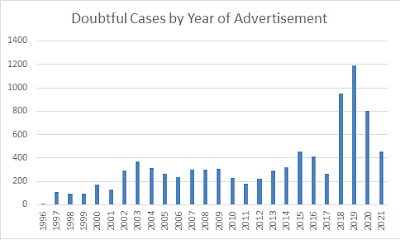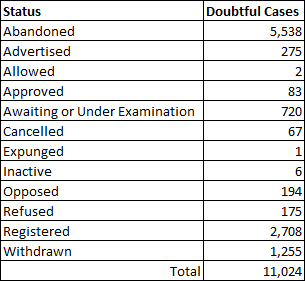Section 37(3) of the Trademarks Act, R.S.C., 1985, c. T-13 (TMA) requires the Registrar to notify the owner of a registered trademark of the advertisement of a pending application if the Registrar “is in doubt whether the trademark claimed in the application is registrable” over the registered mark. The idea is presumably that inter partes opposition proceedings between the registrant and applicant are better suited to resolving such doubt than ex parte examination proceedings.
As of 14 June 2021, CIPO had annotated 11,024 applications (213 of which are inbound Madrid cases) as doubtful pursuant to TMA s. 37(3). You can’t search CIPO’s online database for s. 37(3) annotations, but you will typically1 see the annotations in the Details column if you display the database record for an application having a s. 37(3) annotation. For example, application no. 2057946 bears the red-boxed s. 37(3) annotation shown below on the left. That annotation reflects the information set forth in the <catmk:DoubtfulCaseBag> element found in CIPO’s .xml file for the '946 application as shown below on the right (click to enlarge the image).
The “Section 37(3) Notice” cites the registration—in this case TMA395722—which also appears in the <com:RegistrationNumber> element encapsulated within the <catmk:DoubtfulCaseBag> element. The cited registration’s application number—in this case 0681124—appears in the <com:ST13ApplicationNumber> element encapsulated within the <catmk:DoubtfulCaseBag> element, although that application number is not exposed in the online database record for the '946 application.The chart omits 2,254 “doubtful” cases which have not progressed to the advertisement stage. 1,333 of those cases have been abandoned, 116 have been withdrawn, 4 have been refused, 1 is inactive, 83 have been approved for advertisement and the remaining 717 are awaiting or under examination. Overall, the current status (as of 14 June 2021) of the 11,024 applications bearing “doubtful” annotations is:
1 Alternatively—or sometimes additionally—you may see an Action History entry such as “APPROVED BY PROGRAM EX200M1” for an application having a s. 37(3) “doubtful” annotation.↩
2 An opposition is identified in CIPO’s .xml file for the application in question via the “Opposed” tmk:MarkEvent xml element and its associated tmk:MarkEventDate. These correspond to the “Opposed” Action and the associated Action Date in the the Action History section of CIPO’s online database record for the application in question.↩
3 On the flip side, a spike in “doubtful” annotations—as charted above for 2018-2019—might conceivably yield a corresponding spike in Section 45 proceedings in which the owners of “doubtful” applications attempt to have the cited registrations cancelled or amended to remove the basis for the perceived “doubt”. CIPO’s trademark .xml data includes extensive particulars of 18,312 Section 45 proceedings (as of 14 June 2021). However, in processing the data, I have not extracted details of the number of Section 45 proceedings initiated in each year. I am accordingly unable to comment further at this time.↩





